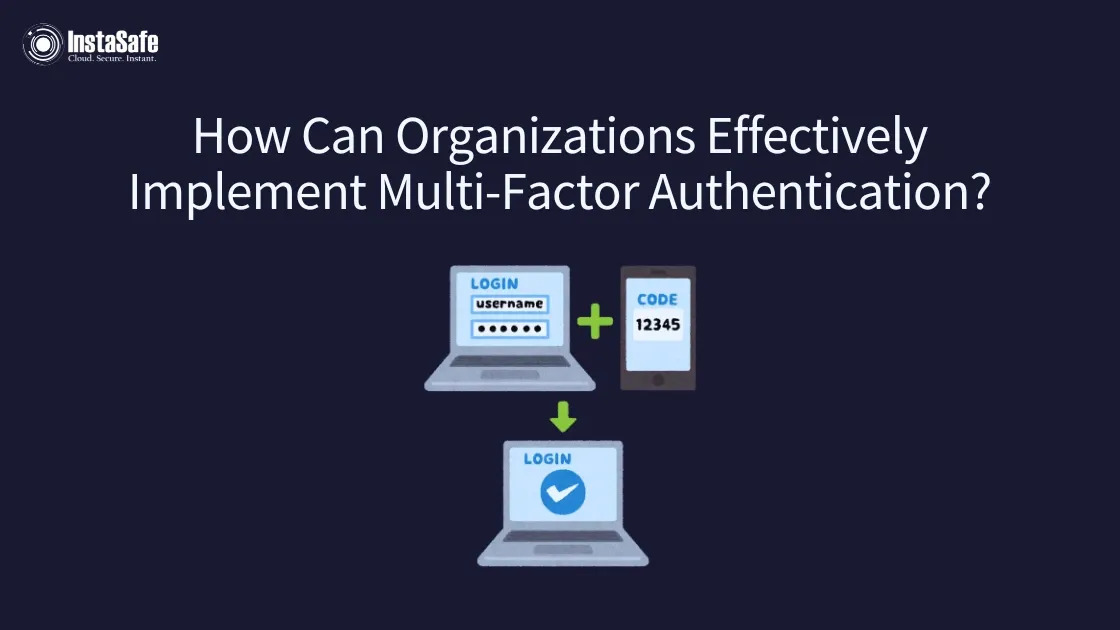How Can Organizations Effectively Implement Multi-Factor Authentication?

Passwords alone no longer provide adequate protection for your company’s assets and data. Today, multi-factor authentication has become indispensable for every organisation that wants to stay protected against cyber attacks.
While many organisations recognise MFA's importance, effectively implementing it is challenging. This blog outlines practical steps to implement MFA smoothly, balancing stronger security with user convenience to create a secure environment that works for your entire organisation.
Understanding Multi-Factor Authentication
Before accessing systems or data, multi-factor authentication requires users to confirm their identity using different methods. These techniques are usually divided into three categories: something you know (password, PIN, etc.), something you have (OTP, authenticator app, etc.) and something you are (face recognition, fingerprints, etc.).
When properly set up, MFA creates multiple barriers that make unauthorised access significantly more difficult. Even if a hacker steals your password, they would still need your phone or fingerprint to break in. This layered approach provides much stronger protection than passwords alone.
Planning Your Multi-Factor Authentication Implementation Strategy
Before rolling out MFA across your organisation, careful planning is essential for success.
1. Assess Your Current Security Needs
Begin by understanding what you are protecting and who needs access. Consider asking these questions:
- Which systems contain your most sensitive data?
- Who needs access to these systems?
- What devices do your employees use?
- Where do your employees work from (office, home, travelling)?
This assessment helps you prioritise which systems need MFA first and which authentication methods make the most sense.
2. Choose the Right Authentication Methods
Not all MFA solutions work the same way. Consider these popular options:
- Mobile authenticator apps (Google Authenticator, Microsoft Authenticator)
- Push notifications to smartphones
- Hardware tokens or security keys
- Biometric verification (fingerprints, facial recognition)
- One-time codes via email or SMS (though SMS is increasingly vulnerable)
Multi-factor authentication best practices suggest using mobile authenticator apps or hardware tokens rather than SMS-based verification when possible, as these provide stronger security.
3. Create Clear MFA Policies
Develop written policies that clearly explain the following:
- Which systems require MFA
- Which authentication methods are approved
- Steps to take if authentication devices are lost
- Who to contact for help with MFA issues
These policies create consistency and clarity across your organisation during authentication deployment.
Step-by-Step Guide to Multi-Factor Authentication Implementation
Step 1: Select the Right MFA Solution
Choose an MFA solution that balances security with usability. Evaluate compatibility with your existing systems, ensuring your chosen solution integrates well with your current infrastructure. Also, ensure user-friendliness because complicated systems can frustrate users and lead to resistance.
When choosing your MFA solution, consider both initial setup costs and ongoing management expenses. To ensure smooth scalability, make sure the solution can add users and systems as your organisation grows. Finally, verify that it supports various authentication methods to ensure flexibility.
Step 2: Start With a Pilot Group
Before deploying your MFA solution organisation-wide, test it with a small group of users. Select tech-savvy employees who can provide helpful feedback on the process. Also include representatives from different departments to understand varied perspectives and usage patterns.
Test with both regular and administrative accounts to ensure all access levels function properly. Make sure to document any issues that arise during the pilot and address them before proceeding further. This testing phase helps identify potential problems before affecting your entire organisation and builds internal expertise in managing the system.
Step 3: Prepare Your Users
Many MFA implementation challenges arise from user resistance or confusion. To overcome, prepare your employees by explaining why MFA is necessary and how it protects both confidential and personal information. Provide clear, simple instructions with images showing exactly how to set up and use the new authentication methods.
Set up dedicated help desk support to assist users with MFA issues, especially during the initial rollout. You can also consider creating short training videos demonstrating the login process with different devices and scenarios. Moreover, always notify your users in advance so that are not surprised by new login requirements.
When users understand the importance of MFA and how to use it, they are more likely to adopt it willingly rather than viewing it as an unnecessary burden.
Step 4: Deploy MFA Gradually
Implement multi-factor authentication in phases to avoid friction in regular operations. Start with IT administrators and security teams who generally have better technical understanding and access to sensitive systems. Next, move to departments handling sensitive data like HR, finance, or legal.
Expand to executive leadership, who often have access to critical company information and may be specific targets for attacks. Finally, implement for all remaining users once you have refined the process and built support capacity. This gradual approach allows your support team to manage the workload of helping users adapt without getting overwhelmed.
Step 5: Monitor and Gather Feedback
After deployment, closely track key indicators of how well your MFA system is working. Monitor failed authentication attempts to identify potential problems or attack patterns. Also, track help desk tickets related to MFA to understand common user issues and improve training or documentation.
Moreover, collect user feedback about their authentication experience to identify friction points. Besides, watch for any security incidents or bypass attempts that might indicate weaknesses in your implementation. Use this data to improve your authentication implementation and fix issues before they escalate.
Overcoming Common Challenges in Multi-Factor Authentication Implementation
Organisations often face several hurdles when they implement MFA.
1. Challenge: User Resistance
When introducing MFA, some users will inevitably resist the change. Address this by explaining security benefits in simple, relatable terms rather than technical jargon. Share real-world examples of password breaches that affected similar organisations to make the threat concrete.
Focus on making the authentication process as simple and quick as possible to minimise inconvenience. Consider providing exceptional support during the transition period, responding quickly to questions and issues. Having visible executive support for the change also helps demonstrate its importance to the organisation.
2. Challenge: Technical Compatibility Issues
Modern authentication systems may not be compatible with your current legacy systems. Before deployment, test MFA with all important apps to find problems. Always have backup authentication methods ready in case primary methods fail or are not supported.
When possible, work directly with software vendors to resolve compatibility problems. For systems that simply would not work with modern authentication, consider upgrading, replacing them or implementing compensating controls to manage the risk.
3. Challenge: Managing Costs
MFA implementation can strain limited IT budgets. Start by protecting your most critical systems first, then expand as resources permit. You may consider free or lower-cost MFA options for less sensitive systems while investing in robust solutions for your crown jewels.
When justifying costs to management, calculate the potential financial impact of a data breach to put the investment in perspective. Check whether any MFA solutions might already be included with existing software subscriptions your company maintains.
Multi-Factor Authentication Best Practices
Follow these multi-factor authentication best practices to maximise security benefits from your implementation.
Require MFA for All Users
While it might seem easier to exempt certain users or departments from MFA requirements, this creates dangerous security gaps.
Senior executives often request exemptions due to busy schedules, but their accounts typically have the highest privileges and access to sensitive information, making them prime targets for attackers.
Implement Risk-Based Authentication
Smart MFA systems can change security depending on login risk. Set up extra verification for suspicious events like new device logins or unexpected geographic locations. Similarly, access attempts outside normal working hours and pay attention to multiple failed login attempts.
Prepare Recovery Options
Some users may inevitably lose their phones or security keys, which they need for authentication. For such scenarios, establish clear procedures for verifying identity before resetting access. This will help you prevent social engineering attacks against your help desk. The best practice is to develop methods for providing temporary access when primary authentication methods are unavailable.
Regularly Review and Update Your MFA System
Security threats evolve constantly, requiring ongoing attention to your authentication systems. Thus, regularly update your multi-factor authentication systems to patch evolving security vulnerabilities.
Educate Users on MFA Security Threats
Even with technical controls in place, users need to understand potential attacks targeting MFA systems. Teach them about MFA fatigue attacks, where attackers bombard users with authentication requests, forcing them to stop the notifications.
Measuring MFA Success
Track specific metrics to evaluate your authentication deployment effectiveness. Another recommended step is to monitor the reduction in unauthorised access attempts compared to pre-MFA baselines. This will help you identify any gaps and detect any room for improvement.
Conclusion
Implementing multi-factor authentication strengthens your organisation's security posture. By carefully planning your approach, selecting appropriate authentication methods and supporting users throughout the transition, you can successfully implement MFA with minimal disruption.
Enhance your security posture today with InstaSafe. Our robust, user-friendly MFA solution seamlessly integrates with your existing systems while providing enterprise-grade protection against modern cyber threats.
Frequently Asked Questions (FAQs)
- How effective is multifactor authentication?
Multi-factor authentication is highly effective, preventing up to 99.9% of automated attacks and significantly reducing account compromise. This authentication deployment creates multiple security layers, making unauthorised access extremely difficult even when passwords are compromised.
- What is the main advantage of implementing MFA?
The main advantage of implementing MFA is strengthened security with relatively simple deployment. By requiring multiple verification factors, organisations can block most unauthorised access attempts, even when credentials are stolen.
- How effective is multifactor authentication at deterring cyberattacks?
Multifactor authentication prevents cyberattacks by eliminating password-only vulnerabilities. When organisations implement MFA, they create additional security barriers that effectively block credential stuffing, phishing attempts, and brute force attacks, significantly reducing overall breach risk.
